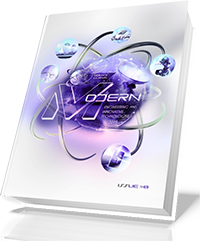INFLUENCE OF STIFFNESS ELLIPSES ORIENTATION AND DISSIPATION CHARACTERISTICS ON THE LATHE DYNAMIC SYSTEM STABILITY DURING CUTTING PROCESS
DOI:
https://doi.org/10.30890/2567-5273.2024-33-00-030Keywords:
tool holder, vibrostability, lathe work, asymptotic sustainability, the dynamics of machine tools, center of rigidityAbstract
The article presents the theoretical studies results of direction influence of reduced stiffness and damping parameters in the machine tools dynamic system called as "cutter tool-workpiece" during turning. The influence determination and compilation of rReferences
Merrit, H. E. (1965). Theory of self-excited machine-tool chatter-contributiont on machine tool chatter research – 1. ASME Journal of Engineering for Industry. (pp. 447–454).
Özlü, E., Araghizad, A. E., Budak, E. (2020). Broaching tool design through force modelling and process simulation. CIRP Annals. (Vols. 69), (pp. 53–56).
Tlusty, J., Polacek, M. (1963). The stability of machine tools against self-excited vibrations in machining. International Research in Production Engineering. (pp. 465–474).
Kudinov, V. A. (1967). Dinamika stankov [Dynamics of machine tools]. Moscow: Mashinostroenie [in Russian].
Tlusty, J. (1956). Avtokolebanija v metallorezhuwih stankah [Self-oscillations in metal-cutting machines]. Moscow: Mashgiz [in Russian].
Vakulenko, S. (2022). Theoretical study of the efficiency of using a special cutter tool holder with an oriented position of center of rigidity. Bulletin of the National Technical University "KhPI". Series: New solutions in modern technology. Kharkiv: NTU "KhPI". (Vols. 2(12)), (pp. 3–9).
Vakulenko, S. (2022). Theoretical study of damping properties influence of special toolholder with an oriented center of rigidity on vibration resistance while turning. Transactions of Kremenchuk Mykhailo Ostrohradskyi National University. Kremenchuk: KRNU. (Vols. 1(132)), (pp. 173-180).
Shmagel, I., Vakulenko, S. (2021). Substantiation and choice of mathematical model structure for theoretical study of vibration resistance increasing problem of the lathe dynamic system during turning. Youth Innovations in Mechanical Engineering. Kyiv: Igor Sikorsky KPI. (Vols. 3), (pp. 179-186).
Axinte, D.A. (2007). An experimental analysis of damped coupled vibrations in broaching. International Journal of Machine Tools and Manufacture. (Vols. 47 (14)), (pp. 2182–2188).
Altintas, Y., Aslan, D. (2017). Integration of virtual and on-line machining process control and monitoring. CIRP Annals. (Vols. 66 (1)), (pp. 349-352).
Ahmadi, K., Altintas, Y. (2014). Identification of machining process damping using output-only modal analysis. Journal of Manufacturing Science and Engineering. (Vols.136 (5)), (pp. 286-295).
Kilic, Z.M., Altintas, Y. (2016). Generalized mechanics and dynamics of metal cutting operations for unified simulations. International Journal of Machine Tools and Manufacture. (Vols.104), (pp. 1-13).
Insperger, T., Stepan, G. (2004). Semi-discretization method for periodic delay-differential equations with discrete delay. International Journal for Numerical Methods in Engineering. (Vols. 61(1)), (pp. 117–141).
Wen, Z., Ding, Y., Liu, P., Ding, H. (2019). An Efficient Identification Method for Dynamic Systems with Coupled Hysteresis and Linear Dynamics: Application to Piezoelectric-actuated Nanopositioning Stages. IEEE/ASME Transactions on Mechatronics. (Vols. 24 (1)), (pp. 326-337).
Fofana, M. S. (2003). Delay dynamical systems and applications to nonlinear machine-tool chatter. Chaos, Solitons and Fractals. (Vols. 17(4)), (pp. 731–747).
Sims, N. D., Mann, B., Huyanan, S. (2008). Analytical prediction of chatter stability for variable pitch and variable helix milling tools. Journal of Sound and Vibration. (Vols. 317 (3-5)), (pp. 664-686).
Downloads
Published
How to Cite
Issue
Section
License
Copyright (c) 2024 Authors

This work is licensed under a Creative Commons Attribution 4.0 International License.






